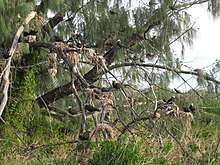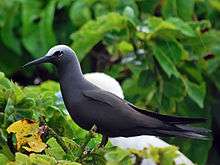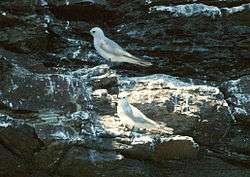Anous
Anous is a genus of seabirds in family Laridae which also contains the gulls, terns and skimmers. The genus contains five species.[1]
| Anous | |
|---|---|
| Brown noddy and black noddy together, Lord Howe Island | |
| Scientific classification | |
| Kingdom: | Animalia |
| Phylum: | Chordata |
| Class: | Aves |
| Order: | Charadriiformes |
| Family: | Laridae |
| Genus: | Anous Stephens, 1826 |
| Species | |
| |
| Synonyms | |
|
Procelsterna Lafresnaye, 1842 | |
The noddies inhabit tropical oceans and have a worldwide distribution, ranging from Hawaii to the Tuamotu Archipelago and Australia in the Pacific Ocean, from the Red Sea to the Seychelles and Australia in the Indian Ocean and in the Caribbean to Tristan da Cunha in the Atlantic Ocean.[2] They nest in colonies on cliffs or in short trees or shrubs, seldom on the ground. The female lays one egg in each breeding season.[2] These birds feed on small fish which they catch by dipping their bills beneath the surface while flying; they do not plunge dive.[3][4][5]
Taxonomy
The genus was introduced by the English naturalist James Francis Stephens in 1826.[6][7] Anous is Ancient Greek for "stupid" or "foolish".[8] Noddies are often unwary and were well known to sailors for their apparent indifference to hunters or predators. They find safety in enormous numbers.[9]
A molecular phylogenetic study published in 2007 found that the genus Anous was a sister group to a clade containing the terns, gulls and skimmers.[10] A study of the phylogenetic relationship between the five noddies published in 2016 found that they formed a single clade with the blue noddy and the grey noddy which were at the time in the genus Procelsterna embedded within the three species in Anous. The authors proposed that the noddies should be merged into a single genus Anous and that Procelsterna should be considered as a junior synonym.[11]

| Image | Scientific name | Common Name | Distribution |
|---|---|---|---|
 | Anous stolidus | Brown noddy or common noddy | from Hawaii to the Tuamotu Archipelago and Australia in the Pacific Ocean, from the Red Sea to the Seychelles and Australia in the Indian Ocean and in the Caribbean to Tristan da Cunha in the Atlantic Ocean. |
 | Anous minutus | Black noddy | the Pacific Ocean and more scattered across the Caribbean, central Atlantic and in the northeast Indian Ocean. |
 | Anous tenuirostris | Lesser noddy, sometimes been considered to be a subspecies of the black noddy.[3] | coastlines of Comoros, Kenya, India, Maldives, Mauritius, Seychelles, Sri Lanka and United Arab Emirates. |
%2C_Ducie_Island.jpg) | Anous cerulea | Blue noddy (formerly placed in Procelsterna) | American Samoa, the Cook Islands, Fiji, French Polynesia, Kiribati, Marshall Islands, New Caledonia, Samoa, Tonga (Niua), Tuvalu and Hawaii. |
 | Anous albivitta | Grey noddy (formerly placed in Procelsterna) | south Pacific Ocean |
References
- Gill, Frank; Donsker, David, eds. (2019). "Noddies, gulls, terns, auks". World Bird List Version 9.2. International Ornithologists' Union. Retrieved 24 June 2019.
- Anous, TOLWEB
- Gochfeld, M.; Burger, J.; Garcia, E.F.J. "Lesser Noddy (Anous tenuirostris)". In del Hoyo, J.; Elliott, A.; Sargatal, J.; Christie, D.A.; de Juana, E. (eds.). Handbook of the Birds of the World Alive. Lynx Edicions. Retrieved 17 April 2017.
- Gochfeld, M.; Burger, J.; Kirwan, G.M.; Garcia, E.F.J. "Brown Noddy (Anous stolidus)". In del Hoyo, J.; Elliott, A.; Sargatal, J.; Christie, D.A.; de Juana, E. (eds.). Handbook of the Birds of the World Alive. Lynx Edicions. Retrieved 17 April 2017.
- Gochfeld, M.; Burger, J.; Kirwan, G.M.; Garcia, E.F.J. "Black Noddy (Anous minutus)". In del Hoyo, J.; Elliott, A.; Sargatal, J.; Christie, D.A.; de Juana, E. (eds.). Handbook of the Birds of the World Alive. Lynx Edicions. Retrieved 17 April 2017.
- Peters, James Lee, ed. (1934). Check-list of Birds of the World. Volume 2. Cambridge, Massachusetts: Harvard University Press. p. 346.
- Stephens, James Francis (1826). General zoology, or Systematic natural history, by George Shaw. Volume 13, Part 1. London: G. Kearsley. p. 139. The title page gives the year as 1825.
- Jobling, James A. (2010). The Helm Dictionary of Scientific Bird Names. London: Christopher Helm. p. 48. ISBN 978-1-4081-2501-4.
- Brown Noddy or Common Noddy
- Baker, A.J.; Pereira, S.L.; Paton, T.A. (2007). "Phylogenetic relationships and divergence times of Charadriiformes genera: multigene evidence for the Cretaceous origin of at least 14 clades of shorebirds". Biology Letters. 3: 205–209. doi:10.1098/rsbl.2006.0606. PMC 2375939. PMID 17284401. Baker, Allan J; Pereira, Sérgio L; Paton, Tara A (2008). "Erratum: Phylogenetic relationships and divergence times of Charadriiformes genera: multigene evidence for the Cretaceous origin of at least 14 clades of shorebirds". Biology Letters. 4: 762–763. doi:10.1098/rsbl.2006.0606erratum.
- Cibois, A.; Thibault, J.-C.; Rocamora, G.; Pasquet, E. (2016). "Molecular phylogeny and systematics of Blue and Grey Noddies (Procelsterna)". Ibis. 158: 433–438. doi:10.1111/ibi.12363.
- Olsen and Larsson, Terns of Europe and North America ISBN 0-7136-4056-1